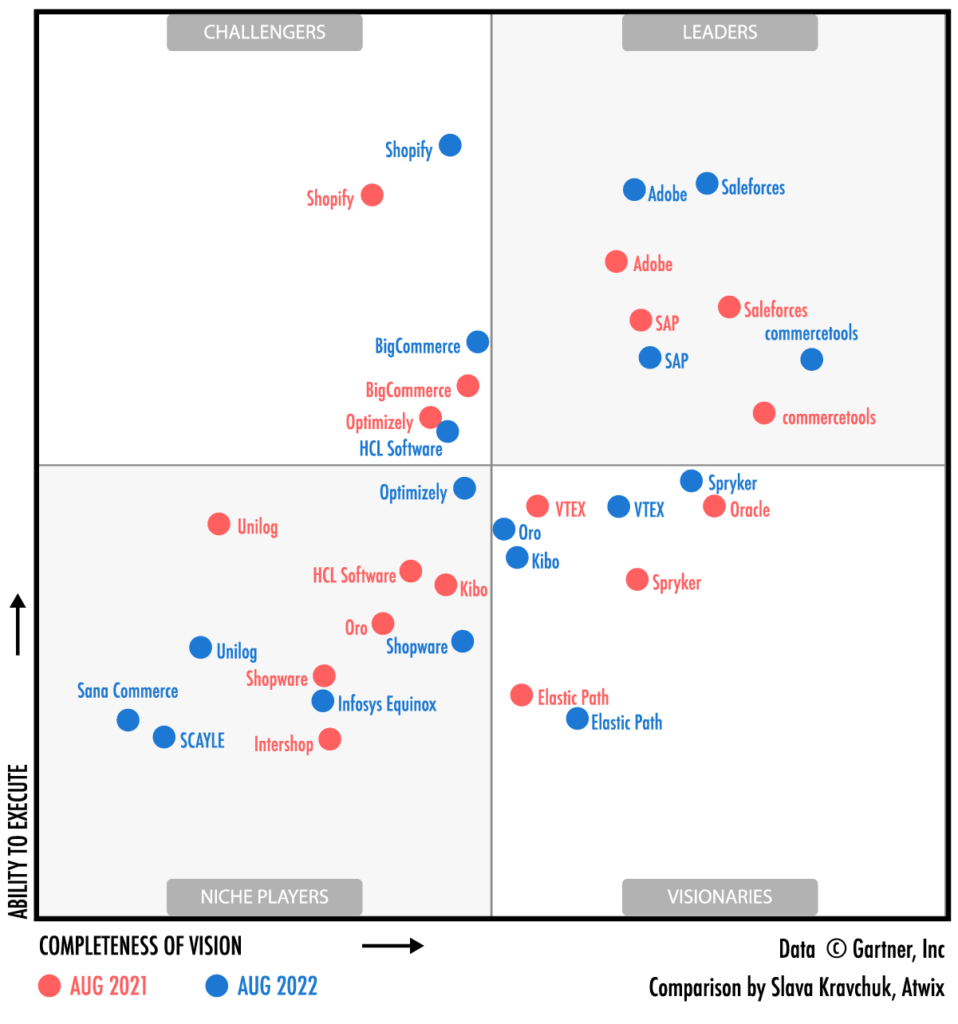Two platforms are no longer in the quadrant as of this year – Oracle and Intershop. While Intershop is still a player, especially in Germany, it looks like Oracle’s DX Commerce platform is to be discontinued. With Oracle gone as a player in Digital Commerce, there’s more opportunity for others, especially in the Leaders quadrant to gain some new business.

New Players in 2022 Gartner’s Ecommerce Quadrant
What most caught my attention looking at this year’s movements is open source platforms gaining momentum. Notably, Oro Commerce, Shopware and Spryker all made significant leaps. I wouldn’t necessarily agree with those platforms’ placements, but the fact that all of them moved in both axes is an impactful assessment.
Farewell
All three platforms still have a somewhat limited global footprint, especially Spryker and Shopware who have the majority of their customers in Europe. However, Shopware in particular seems to be taking over the mid-segment of the DACH digital commerce market and with the fresh 0M in funding and hiring activity in the US, they definitely have an appetite for the American market.
Open Source eCommerce platforms in the Gartner’s Magic Quadrant
Reading the full report I couldn’t help but notice that the major criteria for the evaluation were B2B capabilities. For the most part, platform vendors understand that possessing B2B capabilities is crucial nowadays, however, not many manage to package enough to satisfy B2B merchants and manufacturers. Very few providers are able to serve B2B and B2C from the same solution, and that truly sets Adobe Commerce apart.
You can clearly see the winners and losers of this year’s Gartner Magic Quadrant of Ecommerce Platforms in the comparison picture above, but who is going to be 2023’s hero?
I’d bet that we would see at least one new player in the Leaders Quadrant in 2023. Shopify, BigCommerce and Spryker are all possible candidates as they sit really close to those thin but important lines separating the Leaders from the others. If I were to pick one – I’d say it’s going to be BigCommerce.
Infosys Equinox, Sana Commerce, SCAYLE are three new players entering the Gartner Magic Quadrant for Digital Commerce for the first time. All three seem to really be niche players at the moment – both Sana Commerce and SCAYLE come from Europe and their footprint outside of the European market is yet to be developed. Infosys Equinox doesn’t have a developed partner network and is primarily targeted to Infosys’ clients. Without a doubt though, those platforms are to be watched on how their momentum builds up (or not).
B2B eCommerce in the Magic Quadrant
Last month Gartner released 2022’s version of their Magic Quadrant for Digital Commerce. While many platforms that made it to the Quadrant charged ahead with press releases celebrating success, something else intrigued me. It’s not a snapshot in time that is most interesting, it’s the dynamic that tells us an unabridged story. So I went ahead and put together an overlay of the fresh edition over last year’s one. Whoa! Things look a whole lot more interesting now. Let’s unpack.
Those are a few of my personal takeaways from the 2022 Gartner Magic Digital Commerce Quadrant. I’m looking forward to the next edition to see how the market continues to shape. Feel free to add your opinion and observations below. I’m always happy to hear your take and respond to your comments.
Upcoming Leaders?
Despite significant progress of commerce solutions with an open source component, analysts give favor to cloud and composable commerce. Ease of upgradeability and maintenance costs is a solid factor for merchants in their platform considerations and if a platform is able to deliver seamless upgrades, which is easier in case of cloud-native solutions, that’s a positive factor in the ranking.
What’s interesting and seemingly the elephant in the room is Magento. There’s no mention of Magento Open Source in the Gartner’s report. I wonder whether it is because Gartner’s analysts see Magento Open Source as a variation of Adobe Commerce or there is another rationale at play. As time goes, Magento Open Source and Adobe Commerce will differentiate more and I’m curious to see how that would affect Gartner’s and Forrester’s assessments. Although, I personally have no doubt that Adobe’s position will strengthen going forward, as they integrate Adobe Commerce with the rest of the Adobe’s Experience Platform.
My prediction is that B2B capabilities will remain a major ranking factor and those vendors that give B2B functions priority would improve their positions in next year’s Quadrant.

![[BIG UPDATE] Design #47- Ready in eMarket WordPress Theme](https://pacificliners.com/wp-content/uploads/2022/10/big-update-design-47-ready-in-emarket-wordpress-theme-768x2877.jpg)



